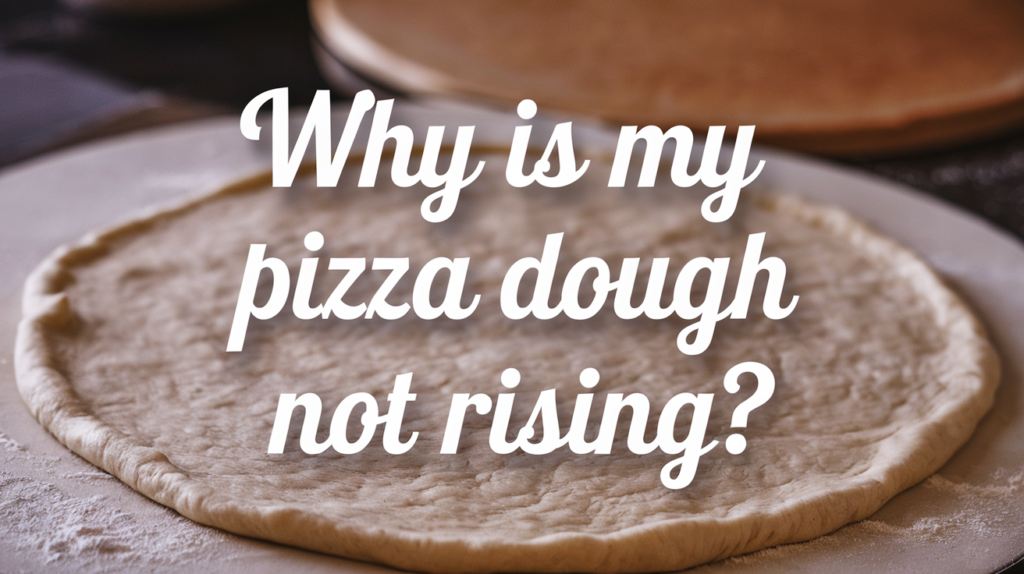There’s nothing quite like the satisfaction of making your own pizza from scratch, but one common frustration many home cooks face is dough that just won’t rise. A fluffy, well-risen dough is the foundation of a delicious pizza crust, so when it falls flat—literally—it can be disappointing. The good news is that understanding the reasons behind this issue can help you avoid it in the future. In this guide, we’ll explore why pizza dough sometimes refuses to rise, the steps you can take to fix it, and tips for ensuring your next batch turns out perfectly every time. Let’s dive into the most common reasons of Why Is My Pizza Dough Not Rising and how to address them.
1. The Yeast Is Old or Inactive
- Reason
If your yeast is expired or has been stored improperly, it may no longer be active. Without active yeast, your dough won’t rise because the fermentation process required to produce gas bubbles (that make the dough rise) won’t occur.
- Solution
- Before using yeast, confirm that it is within its expiration date.
- Conduct a yeast viability test by mixing 1 teaspoon of sugar and 1 teaspoon of yeast in warm water (100°F/38°C). Observe for foam formation within 10 minutes.
- Preserve yeast potency by storing dry yeast in a sealed container, refrigerated or frozen.
2. Not Enough Yeast in the Dough
- Reason
If you use too little yeast, your dough might not rise as expected. Homemade pizza dough often needs a higher yeast-to-flour ratio for a quicker rise.
- Solution
- Use the suggested amount of yeast (typically one packet or about 2 1/4 teaspoons for 3 cups of flour).
- If your kitchen is cold, consider slightly increasing the yeast to compensate for slower fermentation.
3. The Dough Is Too Cold
- Reason
Cold dough slows down yeast activity, which can lead to little or no rising.
- Solution
- Use lukewarm water (around 100°F/38°C) when mixing the dough to activate the yeast.
- Place the dough in a warm, draft-free environment to facilitate rising.
- If the dough feels cold, wrap it in plastic and place it in the oven with a bowl of hot water underneath (don’t turn on the oven). This creates a warm environment without overheating the dough.

4. The Dough Is Too Hot
- Reason
Excessive heat during mixing or proofing can kill the yeast, making it inactive.
- Solution
- Avoid using hot water when activating yeast. Lukewarm water works best.
- If proofing your dough in the oven, ensure the temperature stays below 110°F/43°C.
5. Too Much Salt
- Reason
While salt adds flavor to pizza dough, too much can inhibit yeast activity or even kill the yeast.
- Solution
- Stick to the recipe’s recommended salt-to-flour ratio. The recommended salt ratio is 1 teaspoon per 3 cups of flour.
- Mix salt with the flour before adding it to the yeast mixture to avoid direct contact with the yeast.
6. The Dough Wasn’t Kneaded Enough
- Reason
Kneading facilitates gluten development, enabling the dough to capture yeast-produced gases and rise effectively. If you don’t knead the dough enough, it won’t form the structure needed for a good rise.
- Solution
- Knead the dough for at least 10–15 minutes by hand or 5–7 minutes with a stand mixer until it’s smooth and elastic.
- Conduct the “windowpane test” by gently stretching a small dough sample between your thumb and index finger. 1. If the dough stretches thin without breaking, it’s ready.
7. The Dough Needs More Time
- Reason
Sometimes, the dough simply hasn’t had enough time to rise, especially if you’re using a slow fermentation method.
- Solution
- Be patient! 2. Proof dough at room temperature (1-2 hours) or refrigerate for slower rise. If time is short, increase the yeast slightly for faster results.
8. Bad Water Quality
- Reason
If your tap water contains too many chemicals like chlorine, it can inhibit yeast activity.
- Solution
- Utilize filtered or bottled water to create pizza dough for optimal flavor and texture.
- Utilize lukewarm water (approximately 100°F/38°C) for optimal yeast activity.
9. Environmental Factors (Temperature and Humidity)
- Reason
Cold kitchens or low humidity levels can slow fermentation.
- Solution:
- Proof dough in a warm environment or utilize an oven with a bowl of hot water for controlled temperature.
- Create a warm environment for dough proofing by placing it in the oven with a water bath or covering with a damp cloth in dry kitchens.
Can I Still Use My Dough If It Didn’t Rise?
Yes, you can still use dough that hasn’t risen, but the texture and flavor may differ. Here are some tips for using unrisen dough:
Make Flatbreads or Crackers
- Thinly roll the dough and bake into crispy flatbreads or crackers.
- Brush with olive oil and sprinkle with herbs for extra flavor.
Use as a Thin-Crust Pizza
- Roll the dough thin, top it with your favorite ingredients, and bake it as a thin-crust pizza.
Reproof the Dough
- If the dough hasn’t risen because of cold or inactive yeast, try kneading in a pinch of sugar and letting it rest in a warm place.
What to Do Next Time
If you’re troubleshooting for future dough recipes, keep these tips in mind:
- Use fresh, active yeast.
- Measure ingredients accurately.
- Monitor water temperature carefully.
- Knead the dough thoroughly.
- Allow adequate rising time.
FAQ
Q1. Why is my pizza dough not puffing up in the oven?
- This could be due to under-kneaded dough, insufficient proofing, or an oven that isn’t hot enough. Ensure the dough is well-kneaded and has risen adequately before baking. Heat your oven to 475°F (245°C) for perfect pizza.
Q2. Why isn’t my pizza dough rising in the fridge?
- Cold temperatures slow down yeast activity. If you’re refrigerating dough for a slow rise, it may take 24–48 hours to rise fully.
Q3. Can I fix dough that didn’t rise overnight?
- Try moving the dough to a warm area and giving it more time. If the dough fails to rise, consider replacing the yeast with fresh active yeast. 2. If yeast activity is insufficient, discard old yeast and initiate with fresh yeast.
Final Thoughts
Making perfect pizza dough can be tricky, but with practice and attention to detail, you can master the process. If your dough isn’t rising, review these tips and adjust accordingly. And remember, even unrisen dough can still make delicious pizza or flatbreads. If all else fails, treat yourself to a delicious pizza from a trusted restaurant and try again next time!



